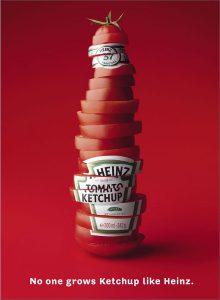What are some of the key questions Barthes aims to investigate in the article?
In “Rhetoric of the Image”, he investigates how images are able to contain messages and bring across an idea efficiently. Using the “Panzani” advertisement, he explores the intentional and the hidden meaning of the visuals and texts used and how they influence our perception.
What are some of the key terms/ concepts introduced and discussed?
3 key concepts were introduced –
1. The linguistic message refers to the captions and labels of the image which can be denotational or connotational. The denoted message is the dictionary meaning while connoted message is the meaning and associate it bears to the denoted message. For example, the name “Panzani” tells viewer the name of the pasta brand and allow us to associate it with Italy subconsciously.
2. The symbolic message refers to the connoted image which is comprehended using our pre-existing knowledge. It requires the viewer to link together different elements of the connotative signs in order to have a deeper understanding.
3. The literal message refers to denoted image which does not imply any code or hidden meaning. Hence, what is visually presented is what we perceive. For example, the packet of pasta simply represents pasta.
Do you agree or disagree with his argument and point of view?
I agree with how Barthes’ analyse and breakdown the different elements of an advertisement. An image of an object may have a meaning but it can differ greatly because of word play or how we portray and frame it.”The one lexis mobilises different lexicons” – The creator can try to relay an idea using an image with both symbolic and literal message but we all comprehend it differently based on our cultural knowledge and opinions.
Provide a brief analysis (200 words) on an advertisement of your choice by using the terms/ concepts proposed by Barthes and discuss the role of text and its relationship with the image in the advertisement. Please include an image the advertisement in your post.

This is an advertisement of tomato sauce by Heinz.
The linguistic message of this poster is “No one grows ketchup like Heinz”. Through this statement, Heinz wants to subtly imply that they are the best ketchup producer in the market as “no one” does it like them. They also used the word “grow” which implies that Heinz cultivate and grow their own tomatoes and this creates an impression of freshness in their products.
When you first look at this ad, the denoted image you get is a ketchup bottle being sliced up into many slices which simply represents the product Heinz is trying to promote. However, when you take a closer look, you will realise that the bottle is actually made up of many tomato slices and the bottle cap is replaced with a tomato stem. The tomato slices all appears to be ripe and juicy which creates a refreshing image in your head. In my opinion, Heinz is trying to bring across the message that they use fresh real tomatoes as ingredients to appeal to consumers that they are a healthier and better option.
You must be logged in to post a comment.